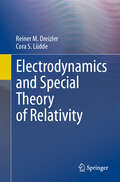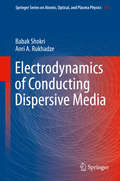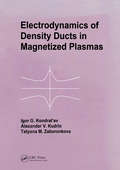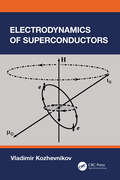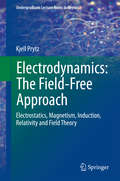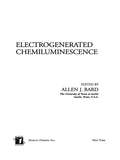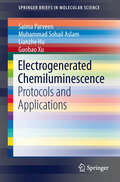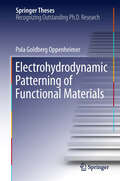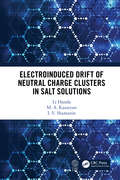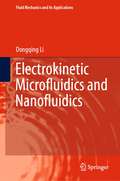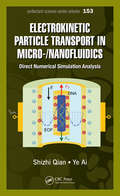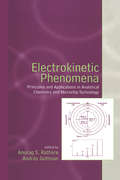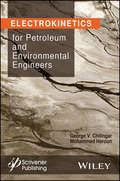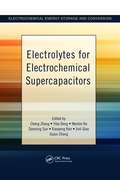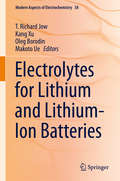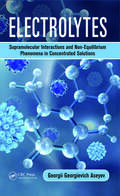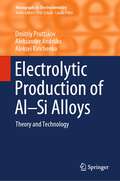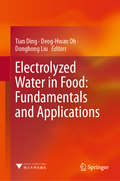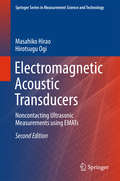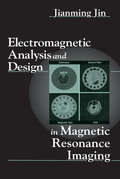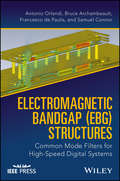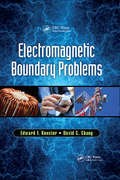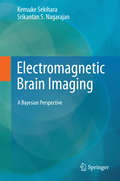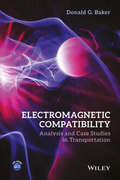- Table View
- List View
Electrodynamics and Special Theory of Relativity
by Reiner M. Dreizler Cora S. LüddeThis textbook offers you a profound understanding of the core concepts in electrodynamics and the special theory of relativity. Emphasis is placed on establishing strong mathematical fundamentals while also equipping you with problem-solving skills crucial for mastering these disciplines. It covers electromagnetic theory, encompassing Maxwell's equations and electromagnetic wave theory as well as special theory of relativity, including space-time principles and the Lorentz transformation.
Electrodynamics of Conducting Dispersive Media (Springer Series on Atomic, Optical, and Plasma Physics #111)
by Babak Shokri Anri A. RukhadzeThis book presents a sequential representation of the electrodynamics of conducting media with dispersion. In addition to the general electrodynamic formalism, specific media such as classical nondegenerate plasma, degenerate metal plasma, magnetoactive anisotropic plasma, atomic hydrogen gas, semiconductors, and molecular crystals are considered.The book draws on such classics as Electrodynamics of plasma and plasma-like media (Silin and Rukhadze) and Principles of Plasma Electrodynamics (Alexandrov, Bogdankevich, and Rukhadze), yet its outlook is thoroughly modern—both in content and presentation, including both classical and quantum approaches. It explores such recent topics as surface waves on thin layers of plasma and non-dispersive media, the permittivity of a monatomic gas with spatial dispersion, and current-driven instabilities in plasma, among many others. Each chapter is equipped with a large number of problems with solutions that have academic and practical importance. This book will appeal to graduate students as well as researchers and other professionals due to its straight-forward yet thorough treatment of electrodynamics in conducting dispersive media.
Electrodynamics of Density Ducts in Magnetized Plasmas: The Mathematical Theory of Excitation and Propagation of Electromagnetic Waves in Plasma Waveguides
by I G Kondratiev A V Kudrin T M ZaboronkovaProviding a systematic and self-contained treatment of excitation, propagation and re- emission of electromagnetic waves guided by density ducts in magnetized plasmas, this book describes in detail the theoretical basis of the electrodynamics of ducts. The classical dielectric-waveguide theory in open guiding systems in magnetoplasma is subjected to rigorous generalization. The authors emphasize the conceptual physical and mathematical aspects of the theory, while demonstrating its applications to problems encountered in actual practice. The opening chapters of the book discuss the underlying physical phenomena, outline some of the results obtained in natural and artificial density ducts, and describe the basic theory crucial to understanding the remainder of the book. The more specialized and complex topics dealt with in subsequent chapters include the theory of guided wave propagation along axially uniform ducts, finding the field excited by the source in the presence of a duct, excitation of guided modes, the asymptotic theory of wave propagation along axially nonuniform ducts, and mode re-emission from a duct. The full wave theory is used throughout most of the book to ensure consistency, and the authors start with simpler cases and gradually increase the complexity of the treatment.
Electrodynamics of Superconductors
by Vladimir KozhevnikovSuperconductivity is a remarkable, on the verge of miraculous, macroscopic quantum phenomenon with a boundless potential for a wide variety of applications. Over the last century the physics of superconductivity constitutes a major part of research in condensed matter and yet the electrodynamics of superconductors appears as only a minor part in textbooks on electrodynamics and superconductivity. The book offers a fresh look at electrodynamics of continuous media with detailed description of thermal and electromagnetic properties of superconductors, emphasising physical meaning of concepts and principles without excessive mathematics. To facilitate understanding, it is accompanied by problems and worked solutions. The book will be of interest to senior undergraduate and graduate students of physics and chemistry who have taken a calculus-based course in general physics. It is a valuable reference for researchers involved in studies of superconductivity, the physics of metals, and condensed matter physics.Key Features: The first book - in terms of semi-classical physics - addressing both equilibrium and nonequilibrium, thermal and transport properties of superconducting materials Presents an accessible overview without excessive mathematics Accompanied by problems with solutions to aid understanding
Electrodynamics: The Field-Free Approach
by Kjell PrytzThis book is intended as an undergraduate textbook in electrodynamics at basic or advanced level. The objective is to attain a general understanding of the electrodynamic theory and its basic experiments and phenomena in order to form a foundation for further studies in the engineering sciences as well as in modern quantum physics. The outline of the book is obtained from the following principles: * Base the theory on the concept of force and mutual interaction * Connect the theory to experiments and observations accessible to the student * Treat the electric, magnetic and inductive phenomena cohesively with respect to force, energy, dipoles and material * Present electrodynamics using the same principles as in the preceding mechanics course * Aim at explaining that theory of relativity is based on the magnetic effect * Introduce field theory after the basic phenomena have been explored in terms of force Although electrodynamics is described in this book from its 1st principles, prior knowledge of about one semester of university studies in mathematics and physics is required, including vector algebra, integral and differential calculus as well as a course in mechanics, treating Newton's laws and the energy principle. The target groups are physics and engineering students, as well as professionals in the field, such as high school teachers and employees in the telecom industry. Chemistry and computer science students may also benefit from the book.
Electrogenerated Chemiluminescence (Monographs In Electroanalytical Chemistry And Electrochemistry Ser.)
by Allen J. BardThe first source on this expanding analytical science, this reference explores advances in the instrumentation, design, and application of techniques with electrogenerated chemiluminescence (ECL), examining the use and impact of ECL-based assays in clinical diagnostics, life science research, environmental testing, food and water evaluation, and th
Electrogenerated Chemiluminescence: Protocols and Applications
by Guobao Xu Lianzhe Hu Muhammad Sohail Aslam Saima ParveenThis book primarily focuses on the fundamentals of and new developments in electrochemiluminescence (ECL), presenting high-quality content and explicitly aiming to summarize and disseminate the current state-of-the-art. The topics covered include the fundamental theory, mechanism, types of reactions involved, and the instrumental techniques. The book also examines the applications of ECL in many of the emerging fields of science, such as bioanalytical, analytical, clinical, pharmaceutical, forensic, military, microchip, µTAS, and LED. It will be invaluable to bioanalysts, drug analysts, pharmaceutical researchers and other professionals worldwide, as well as to other interested readers.
Electrohydrodynamic Patterning of Functional Materials
by Pola Goldberg OppenheimerThis thesis explores a route to induce and control the structure formation process in thin films by the use of strong electric fields. We investigate, establish and apply the use of the electrohydrodynamic (EHD) lithography as a versatile patterning tool on the sub-micrometre and nanometre length scales for functional materials. Thin films are ubiquitous, they are found in nature and used in almost every aspect of daily life. While film instabilities are often undesirable in nature and technology, they can be utilized to produce structures by precisely controlling the destabilization of the film. EHD lithography utilizes instabilities induced by means of an electric field to fabricate periodic structures. EHD patterning is set to become a competitive candidate for low-cost lithographic technology for a number of applications. Herein, the applied potential of this lithographic process is explored by expanding its applicability to a broad range of materials and by a simultaneous patterning of multilayer systems or functional polymers yielding hierarchical architectures with novel functionalities. EHD pattern formation enables for instance, the fabrication of multi-scale structured arrays as surface enhanced Raman scattering (SERS)-active platforms. Furthermore, crystalline and conductive polymers are patterned using the EHD approach and the underlying structure formation mechanisms are discussed. This extension towards functional material systems offers interesting prospects for potential applications. Findings of this thesis are very promising for use in optoelectronic devices.
Electroinduced Drift of Neutral Charge Clusters in Salt Solutions
by M. A. Kazaryan Li Hunda I.V. ShamaninElectroinduced Drift of Neutral Charge Clusters in Salt Solutions presents studies of the processes accompanying the effect of periodic electric and magnetic fields on salt solutions in polar dielectric liquids. The authors explain phenomena from a physical point of view, without theoretical constructions and mathematical calculations. This is done in order to make the book accessible to a wide audience and to help the reader navigate in a multilateral topic that is touched upon when studying processes that occur in liquid media under the external influence of an electromagnetic nature. Additional Features: Explores the phenomenon of selective drift of solvated ions in polar dielectric liquids Applies general principles of electricity and magnetism to describe experimental results Demonstrates how small perturbations of the equilibrium distribution determine not the corrections to the effects but the effects themselves Approaches nonequilibrium molecular physics as a science of physical and chemical processes This book will be useful to specialists, engineers and graduate students, especially those recording and transmitting information in liquid media.
Electrokinetic Microfluidics and Nanofluidics (Fluid Mechanics and Its Applications #133)
by Dongqing LiThis book reviews the latest advancement of microfluidics and nanofluidics with a focus on electrokinetic phenomena in microfluidics and nanofluidics. It provides fundamental understanding of several new interfacial electrokinetic phenomena in microfluidics and nanofluidics. Chapter 1 gives a brief review of the fundamentals of interfacial electrokinetics. Chapter 2 shows induced charge electrokinetic transport phenomena. Chapter 3 presents the new advancement in DC dielectrophoresis. Chapter 4 introduces a novel nanofabrication method and the systematic studies of electrokinetic nanofluidics. Chapter 5 presents electrokinetic phenomena associated with Janus particles and Janus droplets. Chapter 6 introduces a new direction of electrokinetic nanofluidics: nanofluidic iontronics. Chapter 7 discusses an important differential resistive pulse sensor in microfluidics and nanofluidics.
Electrokinetic Particle Transport in Micro-/Nanofluidics: Direct Numerical Simulation Analysis (Surfactant Science)
by Shizhi Qian Ye AiNumerous applications of micro-/nanofluidics are related to particle transport in micro-/nanoscale channels, and electrokinetics has proved to be one of the most promising tools to manipulate particles in micro/nanofluidics. Therefore, a comprehensive understanding of electrokinetic particle transport in micro-/nanoscale channels is crucial to the
Electrokinetic Phenomena: Principles and Applications in Analytical Chemistry and Microchip Technology
by Anurag S. Rathore András GuttmanElectrokinetic Phenomena emphasizes the impact of methods such as capillary zone electrophoresis, capillary electrochromatography, and capillary gel electrophoresis on the analysis of biomolecules. This reference reveals the electrokinetic phenomena that underlie high-performance electro-based analytical tools and vividly depicts how electro
Electrokinetic Remediation for Environmental Security and Sustainability
by Alexandra B. Ribeiro Majeti Narasimha Vara PrasadExplore this comprehensive reference on the remediation of contaminated substrates, filled with cutting-edge research and practical case studies Electrokinetic Remediation for Environmental Security and Sustainability delivers a thorough review of electrokinetic remediation (EKR) for the treatment of inorganic and organic contaminants in contaminated substrates. The book highlights recent progress and developments in EKR in the areas of resource recovery, the removal of pollutants, and environmental remediation. It also discusses the use of EKR in conjunction with nanotechnology and phytoremediation. Throughout the book, case studies are presented that involve the field implementation of EKR technologies. The book also includes discussions of enhanced electrokinetic remediation of dredged co-contaminated sediments, solar-powered bioelectrokinetics for the mitigation of contaminated agricultural soil, advanced electro-fenton for remediation of organics, electrokinetic remediation for PPCPs in contaminated substrates, and the electrokinetic remediation of agrochemicals such as organochlorine compounds. Other topics include: A thorough introduction to the modelling of electrokinetic remediation An exploration of the electrokinetic recovery of tungsten and removal of arsenic from mining secondary resources An analysis of pharmaceutically active compounds in wastewater treatment plants with a discussion of electrochemical advanced oxidation as an on-site treatment A review of rare earth elements, including general concepts and recovery techniques, like electrodialytic extraction A treatment of hydrocarbon-contaminated soil in cold climate conditions Perfect for environmental engineers and scientists, geologists, chemical engineers, biochemical engineers, and scientists working with green technology, Electrokinetic Remediation for Environmental Security and Sustainability will also earn a place in the libraries of academic and industry researchers, engineers, regulators, and policy makers with an interest in the remediation of contaminated natural resources.
Electrokinetics for Petroleum and Environmental Engineers
by George V. Chilingar Mohammed HarounElectrokinetics is a term applied to a group of physicochemical phenomena involving the transport of charges, action of charged particles, effects of applied electric potential and fluid transport in various porous media to allow for a desired migration or flow to be achieved. These phenomena include electrokinetics, electroosmosis, ion migration, electrophoresis, streaming potential and electroviscosity. These phenomena are closely related and all contribute to the transport and migration of different ionic species and chemicals in porous media. The physicochemical and electrochemical properties of a porous medium and the pore fluid, and the magnitudes of the applied electrical potential all impact the direction and velocity of the fluid flow. Also, an electrical potential is generated upon the forced passage of fluid carrying charged particles through a porous medium. The use of electrokinetics in the field of petroleum and environmental engineering was groundbreaking when George Chilingar pioneered its use decades ago, but it has only been in recent years that its full potential has been studied. This is the first volume of its kind ever written, offering the petroleum or environmental engineer a practical "how to" book on using electrokinetics for more efficient and better oil recovery and recovery from difficult reservoirs. This groundbreaking volume is a must-have for any petroleum engineer working in the field, and for students and faculty in petroleum engineering departments worldwide.
Electrolytes for Electrochemical Supercapacitors (Electrochemical Energy Storage and Conversion)
by Jiujun Zhang Jinli Qiao Cheng Zhong Yida Deng Wenbin Hu Daoming Sun Xiaopeng HanElectrolytes for Electrochemical Supercapacitors provides a state-of-the-art overview of the research and development of novel electrolytes and electrolyte configurations and systems to increase the energy density of electrochemical supercapacitors. Comprised of chapters written by leading international scientists active in supercapacitor research
Electrolytes for Lithium and Lithium-Ion Batteries
by T. Richard Jow Kang Xu Oleg Borodin Makoto UeElectrolytes for Lithium and Lithium-ion Batteries provides a comprehensive overview of the scientific understanding and technological development of electrolyte materials in the last several years. This book covers key electrolytes such as LiPF6 salt in mixed-carbonate solvents with additives for the state-of-the-art Li-ion batteries as well as new electrolyte materials developed recently that lay the foundation for future advances This book also reviews the characterization of electrolyte materials for their transport properties, structures, phase relationships, stabilities, and impurities. The book discusses in-depth the electrode-electrolyte interactions and interphasial chemistries that are key for the successful use of the electrolyte in practical devices. The Quantum Mechanical and Molecular Dynamical calculations that has proved to be so powerful in understanding and predicating behavior and properties of materials is also reviewed in this book. Electrolytes for Lithium and Lithium-ion Batteries is ideal for electrochemists, engineers, researchers interested in energy science and technology, material scientists, and physicists working on energy.
Electrolytes: Supramolecular Interactions and Non-Equilibrium Phenomena in Concentrated Solutions
by Georgii Georgievich AseyevElectrolyte solutions play a key role in traditional chemical industry processes as well as other sciences such as hydrometallurgy, geochemistry, and crystal chemistry. Knowledge of electrolyte solutions is also key in oil and gas exploration and production, as well as many other environmental engineering endeavors. Until recently, a gap existed be
Electrolytic Production of Al–Si Alloys: Theory and Technology (Monographs in Electrochemistry)
by Dmitriy Pruttskov Aleksander Andriiko Aleksei KirichenkoThis monograph presents the theoretical background of the industrial process for the production of Al-Si alloys in standard aluminum electrolyzers. It reviews the physical chemistry and electrochemistry of cryolite melts containing silica and focuses on analyzing the exchange reactions in Na3AlF6–Al2O3–SiO2 melts. It presents the kinetics and mechanism of Si(IV) electroreduction in Na3AlF6–Al2O3–SiO2 melts on Al cathodes while the current yields as well as industrial tests performed are discussed. The modern research trends in the field are also overviewed. Providing readers with information not easily obtained in any other single source, this book is of great interest to researchers, graduates, and professionals working in the fields of electrochemistry and technology of cryolite-based melts.
Electrolyzed Water in Food: Fundamentals And Applications
by Tian Ding Deog-Hwan Oh Donghong LiuThis book provides fundamentals, highlights recent developments and offers new perspectives relating to the use of electrolyzed water (EW) as an emerging user- and environmental-friendly broad-spectrum sanitizer, with particular focus on the food industry. It addresses the generation, inactivation, pesticide degradation and safety of food by EW, illustrates the mechanism of the germicidal action of EW and its antimicrobial efficacy against a variety of microorganisms in suspensions. In addition, the sanitizing effects of combining EW with various chemical and physical sanitizing technologies have been evaluated, and recent developments and applications of EW in various areas including fruits and vegetables, meat, aquatic products, environment sterilization, livestock and agriculture has been described. The book can be a go-to reference book of EW for: (1) Researchers who need to understand the role of various parameters in its generation, the bactericidal mechanism of EW and its wide applications for further research and development; (2) Equipment producers who need comprehensive understanding of various factors (e.g. type of electrolyte, flow rates of water and electrolyte) which govern the efficacy of EW and developing its generators; (3) Food processors who need good understanding of EW in order to implement it in the operations and supervisors who need to balance the advantages and limitations of EW and ensuring its safe use.
Electromagnetic Acoustic Transducers
by Masahiko Hirao Hirotsugu OgiThis second edition provides comprehensive information on electromagnetic acoustic transducers (EMATs), from the theory and physical principles of EMATs to the construction of systems and their applications to scientific and industrial ultrasonic measurements on materials. The original version has been complemented with selected ideas on ultrasonic measurement that have emerged since the first edition was released. The book is divided into four parts: PART I offers a self-contained description of the basic elements of coupling mechanisms along with the practical designing of EMATs for various purposes. Several implementations to compensate for EMATs' low transfer efficiency are provided, along with useful tips on how to make an EMAT. PART II describes the principle of electromagnetic acoustic resonance (EMAR), which makes the most of EMATs' contactless nature and is the most successful amplification mechanism for precise measurements of velocity and attenuation. PART III applies EMAR to studying physical acoustics. New measurements have emerged with regard to four major subjects: in situ monitoring of dislocation behavior, determination of anisotropic elastic constants, pointwise elasticity mapping (RUM), and acoustic nonlinearity evolution. PART IV deals with a variety of individual issues encountered in industrial applications, for which the EMATs are believed to be the best solutions. This is proven by a number of field applications.
Electromagnetic Analysis and Design in Magnetic Resonance Imaging (Biomedical Engineering Ser. #1)
by Jianming JinThis book presents a comprehensive treatment of electromagnetic analysis and design of three critical devices for an MRI system - the magnet, gradient coils, and radiofrequency (RF) coils. Electromagnetic Analysis and Design in Magnetic Resonance Imaging is unique in its detailed examination of the analysis and design of the hardware for an MRI system. It takes an engineering perspective to serve the many scientists and engineers in this rapidly expanding field.Chapters present:an introduction to MRIbasic concepts of electromagnetics, including Helmholtz and Maxwell coils, inductance calculation, and magnetic fields produced by special cylindrical and spherical surface currentsprinciples for the analysis and design of gradient coils, including discrete wires and the target field method analysis of RF coils based on the equivalent lumped-circuit model as well as an analysis based on the integral equation formulationsurvey of special purpose RF coilsanalytical and numerical methods for the analysis of electromagnetic fields in biological objectsWith the continued, active development of MRI instrumentation, Electromagnetic Analysis and Design in Magnetic Resonance Imaging presents an excellent, logically organized text - an indispensable resource for engineers, physicists, and graduate students working in the field of MRI.
Electromagnetic Bandgap (EBG) Structures: Common Mode Filters for High Speed Digital Systems
by Samuel Connor Antonio Orlandi Bruce Archambeault Francesco De PaulisAn essential guide to the background, design, and application of common-mode filtering structures in modern high-speed differential communication links Written by a team of experts in the field, Electromagnetic Bandgap (EBG) Structures explores the practical electromagnetic bandgap based common mode filters for power integrity applications and covers the theoretical and practical design approaches for common mode filtering in high-speed printed circuit boards, especially for boards in high data-rate systems. The authors describe the classic applications of electromagnetic bandgap (EBG) structures and the phenomena of common mode generation in high speed digital boards. The text also explores the fundamental electromagnetic mechanisms of the functioning of planar EBGs and considers the impact of planar EBGs on the digital signal propagation of single ended and differential interconnects routed on top or between EBGs. The authors examine the concept, design, and modeling of EBG common mode filters in their two forms: on-board and removable. They also provide several comparisons between measurement and electromagnetic simulations that validate the proposed EBG filters' design approach. This important resource: • Presents information on planar EBG based common mode filters for high speed differential digital systems • Provides systematic analysis of the fundamental mechanisms of planar EBG structures • Offers detailed design methodology to create EBG filters without the need for repeated full-wave electromagnetic analysis • Demonstrates techniques for use in practical real-world designs Electromagnetic Bandgap (EBG) Structures: Common Mode Filters for High Speed Digital Systems offers an introduction to the background, design, and application of common-mode filtering structures in modern high-speed differential communication links, a critical issue in high-speed and high-performance systems.
Electromagnetic Boundary Problems
by Edward F. Kuester David C. ChangElectromagnetic Boundary Problems introduces the formulation and solution of Maxwell's equations describing electromagnetism. Based on a one-semester graduate-level course taught by the authors, the text covers material parameters, equivalence principles, field and source (stream) potentials, and uniqueness, as well as:Provides analytical solutions
Electromagnetic Brain Imaging
by Kensuke Sekihara Srikantan S. NagarajanThis graduate level textbook provides a coherent introduction to the body of main-stream algorithms used in electromagnetic brain imaging, with specific emphasis on novel Bayesian algorithms. It helps readers to more easily understand literature in biomedical engineering and related fields and be ready to pursue research in either the engineering or the neuroscientific aspects of electromagnetic brain imaging. This textbook will not only appeal to graduate students but all scientists and engineers engaged in research on electromagnetic brain imaging.
Electromagnetic Compatibility
by Donald G. BakerExplains and resolves the electromagnetic compatibility challenges faced by engineers in transportation and communications This book is a mathematically-rich extension of courses required to maintain the Federal Communications Commission (FCC), the Canadian Standards Association (CSA), and the European Union certifications. The text provides an in-depth study of the electromagnetic compatibility (EMC) issues related to specific topics in transportation and communications, including Light Rail Transit, shadow effects, and radio dead spots, through the analysis of real-world case studies in the United States and Europe. The author provides Cartesian, cylindrical, and spherical solutions that can be applied to Maxwell's and Wave Equations. The book covers topics such as SCADA Systems, shielding, and complexities of radio frequencies and their effect on communication houses. The author also provides information for alternative industries to apply the solutions from the case studies and background content to their own professions. Presents a series of over twenty real-world case studies related to EMC in transportation and communications Covers power line radiation, shadow effects on subway cars, train control systems, and edge distortions Includes the OATS testing method and Department of Transportation (DOT) test Provides access to a companion website housing power point slides and additional appendices Electromagnetic Compatibility: Analysis and Case Studies in Transportation is a reference for practicing engineers involved in transportation and communications, as well as post-graduate engineering students studying transportation and communications in engineering.
